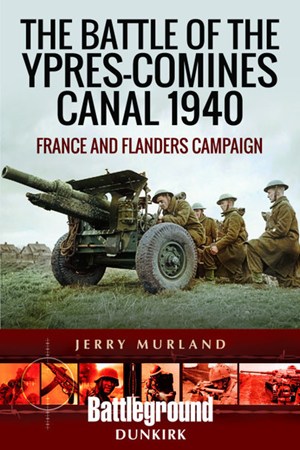THE BATTLE OF THE YPRES-COMINES CANAL 1940
Author: Jerry Murland
Publisher: Pen & Sword; 154 pages with numerous photographs
Published: November 2019
Price: £12.99
ISBN: 9781473852570
Publishers Blurb - Known in some accounts as the Battle of Wijtschaete, the confrontation along the Ypres-Comines Canal in 1940 is still hardly remembered in this country and, apart from the battle honours displayed proudly on the colours of the regiments who took part – many no longer in existence, very little has been written about the four days which probably saved the British Expeditionary Force (BEF) from almost complete destruction. This is quite surprising, given the pivotal nature of the battle, for without the sacrifice of the battalions on the canal there would probably have been no evacuation from Dunkerque on the scale to which we have become accustomed, and the war may well have taken on a different outcome.
Although there was fighting north of Ypres along the Canal Van Ieper Naar De Ijzer, where 151 Brigade and the 3rd Division were deployed, the actual Battle of the Ypres-Comines Canal took place to the south, where the three divisions of General der Infantry Viktor von Schwedler’s IV Korps were pitted against three British brigades along the disused canal which runs from Comines in the south to Ypres in the north.
The book looks in detail at the order of battle of the British and German units engaged and focuses on the four British brigades that fought on the canal. The mainly territorial 143 Brigade was positioned in the south, 13 Brigade was in the middle and 17 Brigade held the northern end of the line up to Zillebeke Lake. Apart from the 12/Lancers and a few tanks from 3/RTR, Ypres itself was largely defended by 150 Brigade. Major General Franklyn’s instructions were to hold the line for as long as possible to allow the remainder of the BEF to strengthen the Dunkerque Perimeter.
With over 150 contemporary and modern black and white photographs, ten maps, and visits to eight CWGC Cemeteries, the book enables the battlefield tourist to explore the area and undertake three car tours together with two short walks. Visitors will no doubt wish to combine a visit to the First World War sites around Ypres with the fighting along the canal in 1940, recognizing many places that were fought over in both wars.
REVIEW: Whilst there is much focus on Dunkirk and the evacuation of the BEF in 1940, less is mentioned on the important British rear-guard actions that arguably helped the extraction of 300,000 British and French troops at Dunkirk. Many of these actions, played out during the last few days of the France and Flanders Campaign is on ground that is probably most familiar to those studying the Great War, and the battles of Ypres. On Ypres sacred soil where in 1914 the Imperial German onslaught was stopped; in 1915 witnessed the first use of poison gas; in 1917 the Third Battle of Ypres and the battle of Passchendaele, and in 1918 when the city was almost lost before the final 100 days to allied victory.
The 1940 story is somewhat different, but whilst there was no major battles, a series of brave last stands helped to stem Nazi Germany’s advance to the channel ports. Fallen back on to the exposed beaches at Dunkirk the subsequent evacuation of the British Army and some French, was the end of the Battle of France, but the beginning of the Battle of Britain and continued resistance to the eventual allied landing in Normandy in June 1944, and victory in Europe less than a year later.
Whilst other books in this series cover the actions at Escaut, Arras, Hazebrouch and elsewhere, this volume zooms in on the British actions along the Ypres-Comines Canal. Here the British rear guard fought with courage and distinction, surprising the Germans in many ways as they did not expect Britain to fight, but surrender. Those who may be more familiar with Great War battles will read about Hill 60, Shrapnel Corner, St Eloi, Warneton and Comines from the lens of 1940. The book includes the story of the brave action of Private Anthony Wynne at the bridge at Houthem, stopping the German advance for nearly two days. The defence of Hill 60 by Royal Scots Fusiliers and their counter attack at Caterpillar Crater, to the demolishing of the bridge by Lt David Smith at the Menin Gate. all previous stories I had not been aware of.
The book is an another excellent guide to those actions and the battlefield as it is today. Well illustrated in this hugely popular battleground pocket-sized series, it describes the story of these actions and offers three tours of the area to understand the fighting in more detail. It is a must read for anyone interested in this area of Belgium and wants to learn more about what happened here in those dark days of May 1940. Highly recommended.
Pen & Sword Link: https://www.pen-and-sword.co.uk/The-Battle-of-the-Ypres-Comines-Canal-1940-Paperback/p/16861


